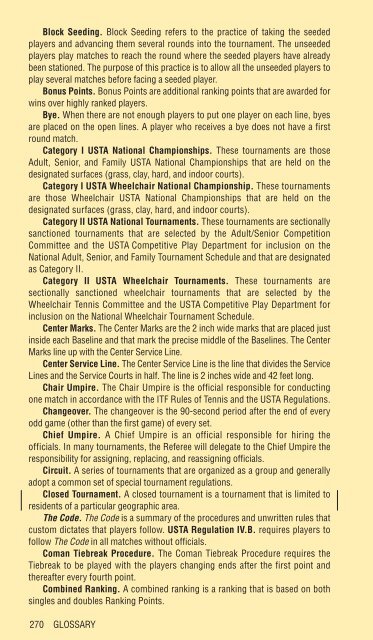FRIEND AT COURT 2010 - USTA.com
FRIEND AT COURT 2010 - USTA.com
FRIEND AT COURT 2010 - USTA.com
You also want an ePaper? Increase the reach of your titles
YUMPU automatically turns print PDFs into web optimized ePapers that Google loves.
Block Seeding. Block Seeding refers to the practice of taking the seeded<br />
players and advancing them several rounds into the tournament. The unseeded<br />
players play matches to reach the round where the seeded players have already<br />
been stationed. The purpose of this practice is to allow all the unseeded players to<br />
play several matches before facing a seeded player.<br />
Bonus Points. Bonus Points are additional ranking points that are awarded for<br />
wins over highly ranked players.<br />
Bye. When there are not enough players to put one player on each line, byes<br />
are placed on the open lines. A player who receives a bye does not have a first<br />
round match.<br />
Category I <strong>USTA</strong> National Championships. These tournaments are those<br />
Adult, Senior, and Family <strong>USTA</strong> National Championships that are held on the<br />
designated surfaces (grass, clay, hard, and indoor courts).<br />
Category I <strong>USTA</strong> Wheelchair National Championship. These tournaments<br />
are those Wheelchair <strong>USTA</strong> National Championships that are held on the<br />
designated surfaces (grass, clay, hard, and indoor courts).<br />
Category II <strong>USTA</strong> National Tournaments. These tournaments are sectionally<br />
sanctioned tournaments that are selected by the Adult/Senior Competition<br />
Committee and the <strong>USTA</strong> Competitive Play Department for inclusion on the<br />
National Adult, Senior, and Family Tournament Schedule and that are designated<br />
as Category II.<br />
Category II <strong>USTA</strong> Wheelchair Tournaments. These tournaments are<br />
sectionally sanctioned wheelchair tournaments that are selected by the<br />
Wheelchair Tennis Committee and the <strong>USTA</strong> Competitive Play Department for<br />
inclusion on the National Wheelchair Tournament Schedule.<br />
Center Marks. The Center Marks are the 2 inch wide marks that are placed just<br />
inside each Baseline and that mark the precise middle of the Baselines. The Center<br />
Marks line up with the Center Service Line.<br />
Center Service Line. The Center Service Line is the line that divides the Service<br />
Lines and the Service Courts in half. The line is 2 inches wide and 42 feet long.<br />
Chair Umpire. The Chair Umpire is the official responsible for conducting<br />
one match in accordance with the ITF Rules of Tennis and the <strong>USTA</strong> Regulations.<br />
Changeover. The changeover is the 90-second period after the end of every<br />
odd game (other than the first game) of every set.<br />
Chief Umpire. A Chief Umpire is an official responsible for hiring the<br />
officials. In many tournaments, the Referee will delegate to the Chief Umpire the<br />
responsibility for assigning, replacing, and reassigning officials.<br />
Circuit. A series of tournaments that are organized as a group and generally<br />
adopt a <strong>com</strong>mon set of special tournament regulations.<br />
Closed Tournament. A closed tournament is a tournament that is limited to<br />
residents of a particular geographic area.<br />
The Code. The Code is a summary of the procedures and unwritten rules that<br />
custom dictates that players follow. <strong>USTA</strong> Regulation IV.B. requires players to<br />
follow The Code in all matches without officials.<br />
Coman Tiebreak Procedure. The Coman Tiebreak Procedure requires the<br />
Tiebreak to be played with the players changing ends after the first point and<br />
thereafter every fourth point.<br />
Combined Ranking. A <strong>com</strong>bined ranking is a ranking that is based on both<br />
singles and doubles Ranking Points.<br />
270 GLOSSARY







![COMPLETE - 2013 Tournament Schedule [11_20_12] - USTA.com](https://img.yumpu.com/21906454/1/190x245/complete-2013-tournament-schedule-11-20-12-ustacom.jpg?quality=85)









